The method below does the trick. Pseudo-code:
- (1) For every pixel of
containingImage  :
:
- Begin matching the
toBeReplaced  (pixel by pixel)
(pixel by pixel)
- If it finds it (all pixels matched), it goes and replaces all of them with
replaceWithThis 
- If not, goes back to (1)
As all patterns will be found, finally, it will return returnImage  .
.
replaceInsideBufferedImage() code:
public static BufferedImage replaceInsideBufferedImage(BufferedImage containingImage, BufferedImage toBeReplaced, BufferedImage replaceWithThis) {
BufferedImage returnImage = deepCopyImage(containingImage);
for (int x = 0; x+toBeReplaced.getWidth() < containingImage.getWidth(); x++) {
for (int y = 0; y+toBeReplaced.getHeight() < containingImage.getHeight(); y++) {
BufferedImage subImg = containingImage.getSubimage(x, y, toBeReplaced.getWidth(), toBeReplaced.getHeight());
if (imageEquals(subImg,toBeReplaced)) {
for (int sx = 0; sx < replaceWithThis.getWidth(); sx++) {
for (int sy = 0; sy < replaceWithThis.getHeight(); sy++) {
returnImage.setRGB(x+sx, y+sy, replaceWithThis.getRGB(sx, sy));
}
}
}
}
}
return returnImage;
}
Full working code:
import java.awt.image.BufferedImage;
import java.awt.image.ColorModel;
import java.awt.image.WritableRaster;
import java.io.File;
import javax.imageio.ImageIO;
public class ReplacePattern {
public static void main(String[] args) throws Exception {
BufferedImage containingImage = ImageIO.read(new File("fourWhites.png"));
BufferedImage toBeReplaced = ImageIO.read(new File("oneWhite.png"));
BufferedImage replaceWithThis = ImageIO.read(new File("oneRed.png"));
BufferedImage replaced = replaceInsideBufferedImage(containingImage, toBeReplaced, replaceWithThis);
ImageIO.write(replaced, "png", new File("fourReds.png"));
}
public static BufferedImage replaceInsideBufferedImage(BufferedImage containingImage, BufferedImage toBeReplaced, BufferedImage replaceWithThis) {
BufferedImage returnImage = deepCopyImage(containingImage);
for (int x = 0; x+toBeReplaced.getWidth() < containingImage.getWidth(); x++) {
for (int y = 0; y+toBeReplaced.getHeight() < containingImage.getHeight(); y++) {
BufferedImage subImg = containingImage.getSubimage(x, y, toBeReplaced.getWidth(), toBeReplaced.getHeight());
if (imageEquals(subImg,toBeReplaced)) {
for (int sx = 0; sx < replaceWithThis.getWidth(); sx++) {
for (int sy = 0; sy < replaceWithThis.getHeight(); sy++) {
returnImage.setRGB(x+sx, y+sy, replaceWithThis.getRGB(sx, sy));
}
}
}
}
}
return returnImage;
}
// http://stackoverflow.com/a/3514297/1850609
public static BufferedImage deepCopyImage(BufferedImage bi) {
ColorModel cm = bi.getColorModel();
boolean isAlphaPremultiplied = cm.isAlphaPremultiplied();
WritableRaster raster = bi.copyData(null);
return new BufferedImage(cm, raster, isAlphaPremultiplied, null);
}
// http://stackoverflow.com/a/11006474/1850609
private static boolean imageEquals(BufferedImage image1, BufferedImage image2) {
int width;
int height;
boolean imagesEqual = true;
if( image1.getWidth() == ( width = image2.getWidth() ) &&
image1.getHeight() == ( height = image2.getHeight() ) ){
for(int x = 0;imagesEqual == true && x < width; x++){
for(int y = 0;imagesEqual == true && y < height; y++){
if( image1.getRGB(x, y) != image2.getRGB(x, y) ){
imagesEqual = false;
}
}
}
}else{
imagesEqual = false;
}
return imagesEqual;
}
}
 could be replaced with
could be replaced with  inside
inside  , so that
, so that  is produced as a result.
is produced as a result.